
|
Decription of piece symbols
|
|||||||||||||||||||||||||||||||||||||||||||||||||||||||||||||||||||||||||||||||||||||||||||||||||||||||||||||||||||||||||||
| Capitals (K, Q, ..., P) describe white pieces; Small letters (k, q, ..., p) describe black pieces. |
||||||||||||||||||||||||||||||||||||||||||||||||||||||||||||||||||||||||||||||||||||||||||||||||||||||||||||||||||||||||||||
 White:King
e1; Queen a1; Rook c1, h1; Knight b1, d1; Bishop f1, g1; Pawn a2, b2, c2,
d2, e2, f2, g2, h2.
White:King
e1; Queen a1; Rook c1, h1; Knight b1, d1; Bishop f1, g1; Pawn a2, b2, c2,
d2, e2, f2, g2, h2.
Black: King e8; Queen a8; Rook c8, h8; Knight b8, d8; Bishop
f8, g8; Pawn a7, b7, c7, d7, e7, f7, g7, h7.
1.Nbc3 2.e5 Ne6 3.f3 e4 Ne3 4.d5 d4 d:c3 c:d2+ 5.K:d2 Ba6 B:b7 B:a8 Nc4 6.Nf4 Kd7 Nc6 Na5 R:a8 Nc4+ 7.Ke1 b4 Q:e5 Q:f4 e5 Q:c4 Qd4+

8.Bd6 c5 c:d4 Rc8 R:c2 Rc3 B:b4 R:c1++ 9.Ke2 B:d4 R:c1 Rc8 R:g8 R:g7 R:h7 R:h8 Rh3

10.Resigns 1-0
Goudreau - Kok
1.Ne3 2.a5 a4 3.a3 c4 Nc3 4.f5 f4 f:e3 e:d2+ 5.K:d2 g4 Bg2 B:b7 B:a8
6.B:c4 d5 d4 B:e2 B:g4 d:c3+ 7.Resigns
[and withdraws from the tournament] 0-1
1.b3 2.e5 f5 3.Qd4 Q:a7 Q:a8

4.b5 Bd5 B:a8 d5 5.c4 c:d5 R:c7 R:c8 Nb2
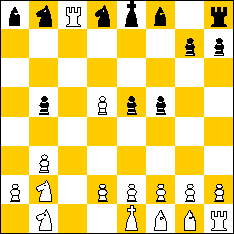
6.f4 f3 B:d5 f:e2 B:g2 e:f1=Q# 0-1
1.e4 2.Ne6 b5 3.f4 f5 f:e6 4.d5 d:e4 f5 B:e6
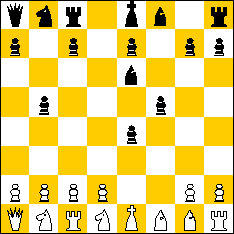
1.Ne3 2.Nbc6 e5 3.Nc4 Nb6 N:a8 4.Nd4 Nb3 N:a1 f6 5.Nc3 Nb5 N:a7 N:c8 N:c7+
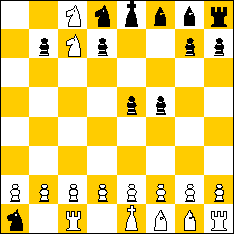
6.Kf7 Bd6 B:c7 Nb3 N:c1 g5

7.Nb6 N:d7 b4 Kd1 K:c1 Kb2 g3
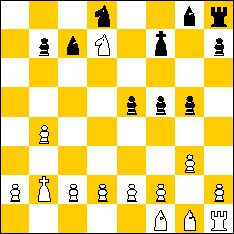
8.e4 e3 e:d2 d1=Q Kg6 Bf4 Bd2 Qc1# 0-1
1.e4 2.c5 c4 3.Nbc3 a4 a5 4.b5 b4 b:c3 Q:e4+ 5.Be2 Qa4 b:c3 Q:c4 Q:e4

6.d5 d:e4 R:c3 R:c2 R:c1 Kd7
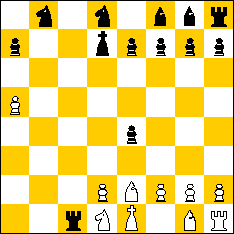
7.h4 Rh3 Rc3 R:c1 Nc3 N:e4 Bb5+

8.Ke6 Ke5 h5 Rh6 Rc6 Ne6 Nf4 R:c1# 0-1
1.g3 2.c6 h5 3.a4 Ne3 Nc3 4.h4 h:g3 g2 g:f1=R+
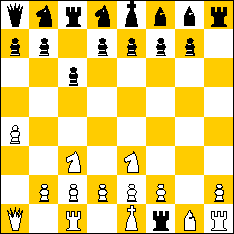
1.Nbc3 2.e5 Ne6 3.e4 Ne3 Be2 4.h5 d5 d4 d:e3

5.Bg4 B:e6 B:c8 B:b7 B:a8 6.Rh6 Rf6 R:f2 f6 Bc4 Rf1# 0-1
1.e4 2.f5 e5 3.f4 f:e5 d3 4.f:e4 e3 Be6 Bb4+

5.c3 c:b4 B:e3 Nf2 Nc3

6.Rf8 R:f2 b6 Q:g2 Q:h1 Q:f1# 0-1
1.b4 2.d5 e5 3.f4 e4 Bb5+

4.c6 c:b5 Ndc6 d:e4
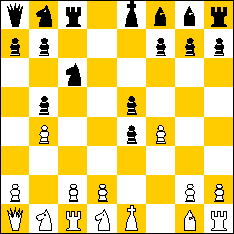
5.Bb6 f:e5 e6 Qf6 Q:f7??

Pfeiffer thought there was a knight on g8. Later he found that he could have mated: 5.Bc5 f:e5 e6 Q:g7 Q:f8#
6.B:f7 Bh5 a:b6 Qa3 Qf3 Qe2# 0-1
1.b4 2.a5 a:b4 3.a3 a:b4 Q:a8 4.Nbc6 R:a8 N:b4 f5

1.e4 2.b6 f6 3.Be2 Nbc3 Bh5+ 4.Bf7 Bh5 b5 b4 5.a3 a:b4 Q:a7 Q:a8 Ne3

6.Nc6 N:b4 R:a8 Ra1 R:c1+
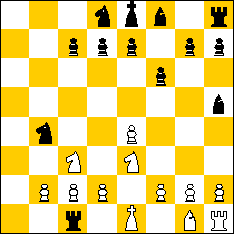
7.Ned1 e5 e6 Nb5 N:c7# 1-0
1.Ndc3 2.b5 h5 3.e4 B:b5 f4 4.c6 c:b5 R:c3 Re3+
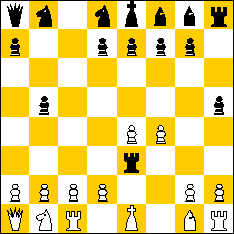
1.b4 2.e5 f5 3.Qd4 Q:a7 Q:a8 4.Nbc6 R:a8 b5 d5

5.Ne3 N:d5 Nb6 N:a8 d3
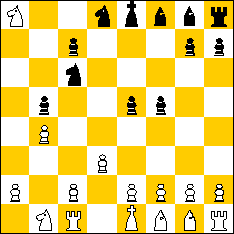
1.b4 2.b5 f6 3.Qd4 Qd5 Q:a8
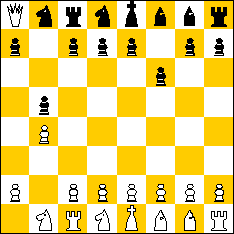 Qd4 Q:a7
Q:a8 would have taken an extra pawn. (HB)
Qd4 Q:a7
Q:a8 would have taken an extra pawn. (HB)
4.Bd5 B:a8 B:g2 B:h1
 White
hadn't seen this B sequence
White
hadn't seen this B sequence
5.Bg2 B:h1 e4 f4 Kf2
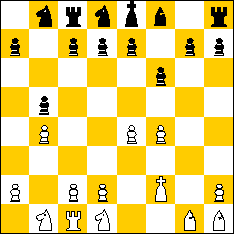 Trying
to avoid future attacks from black g pawn, but white is playing too defensively.
Trying
to avoid future attacks from black g pawn, but white is playing too defensively.
6.e5 B:b4 B:d2 B:f4 B:h2 B:g1+
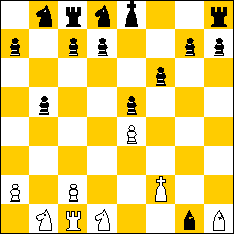 (!) That was good,
because: 1. blocks the dangerous white e-pawn; 2. leaves white bishop at
h1 almost out of the game; 3. stops several mating lines; 4. takes 4 pawns
in a single move (this will reveal decisive); note that the rook in c1
could also be taken, but the g1 Bishop would remain very effective against
black pawns.
(!) That was good,
because: 1. blocks the dangerous white e-pawn; 2. leaves white bishop at
h1 almost out of the game; 3. stops several mating lines; 4. takes 4 pawns
in a single move (this will reveal decisive); note that the rook in c1
could also be taken, but the g1 Bishop would remain very effective against
black pawns.
7.Ke2 Ndc3 N:b5 N:a7 N:c8 R:g1 Re1
 A good defensive
move, thinking about a possible invasion of black h1 Rook.
A good defensive
move, thinking about a possible invasion of black h1 Rook.
8.Nbc6 Nb4 N:a2 Nb4 N:c2 N:e1 d6 Kf7
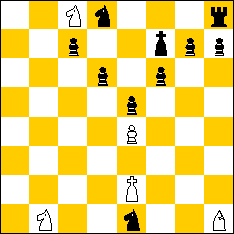 (!) Now
the King is protecting the 4 most important pieces (d and e pawns, rook
and knight) against white Knight sequences. Trying to defend black e1 Knight
would lead to complications, as also trying to promote black g7 pawn.
(!) Now
the King is protecting the 4 most important pieces (d and e pawns, rook
and knight) against white Knight sequences. Trying to defend black e1 Knight
would lead to complications, as also trying to promote black g7 pawn.
9.Nc3 Nd5 N:c7 Ne6 N:g7 Ne7 Ng6 K:e1 N:h8+
10.K:g7 K:h8 Kg7 Ne6 Ng5 N:e4 Ng3 N:a1 d5 d4 11.Resigns 0-1 [comments:
Montero]
1.e4 2.f5 f4 3.f3 a4 a5 4.Bc4 B:f1 Ba6 d6 5.b4 b5 b:a6 a:b7 b:a8=Q
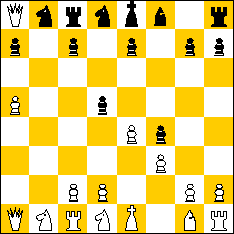
6.Na6 R:a8 Rb8 R:b1 R:a1 R:c1

7.Bd4 B:g7 B:f8 Bg7 B:h8 Bb2 B:c1 [7.e5 e6 c4 c5 c:d6 d7# (apf)]
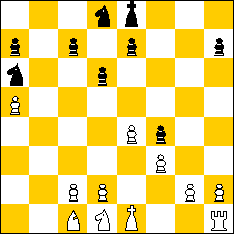
8.d5 d:e4 e:f3 f:g2 f3 Nc5 Ne4 g:h1=Q# 0-1
1.e4 2.f5 f:e4 3.Ndc3 Nb5 N:c7+
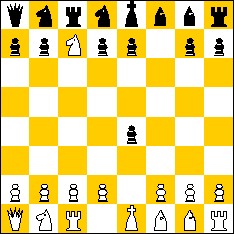
1.e4 2.e5 a6 3.B:a6 B:b7 B:a8 4.Ba3 B:b2 B:a1 Ne6 5.Bb7 B:c8 Nbc3 R:a1 Ne3 6.f5 f4 f:e3 Ke7 Nd4 N:c2+

7.Ke2 d:e3 Rb1 Ba6 R:b8 R:g8 R:h8

8.g5 g4 g3 g:h2 h:g1=Q Q:h1 Na3 Kf7
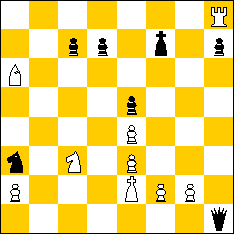
9.f3 f4 f5 f6 g4 g5 Rg8 Bb7 Bd5# 1-0
1.b3 2.e5 Nbc6 3.a4 Qa3 Q:f8+ 4.K:f8 f5 b5 b:a4

5.e3 Bb5 B:c6 B:a8 b:a4
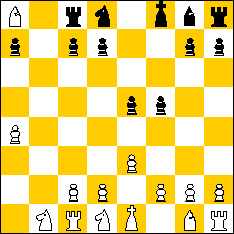
6.e4 h5 Bc4 Ne6 Nf4 N:g2# 0-1